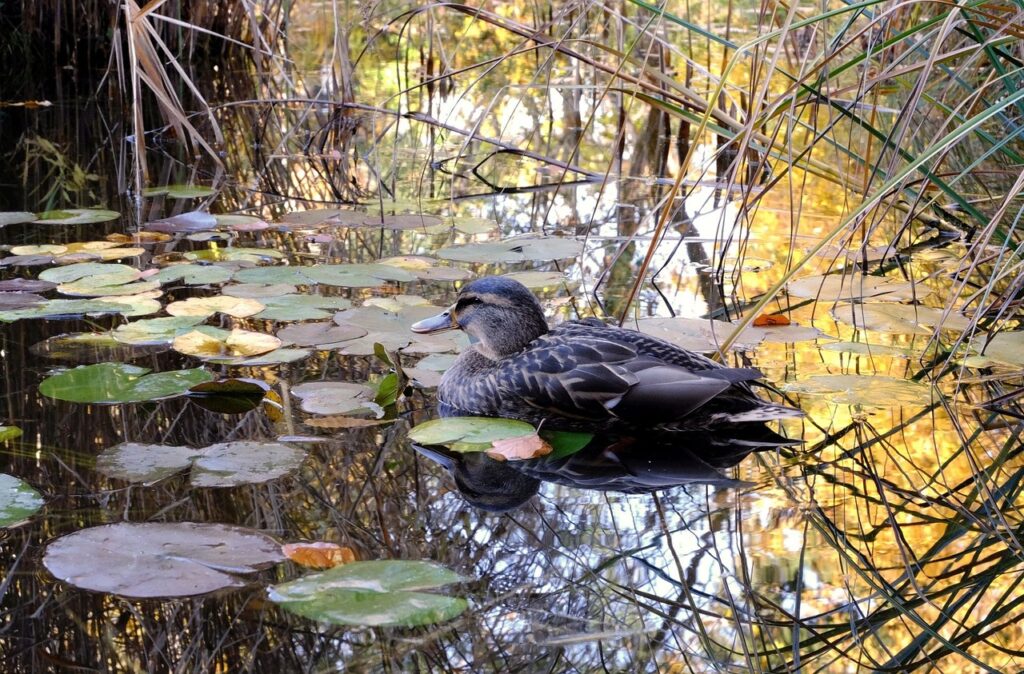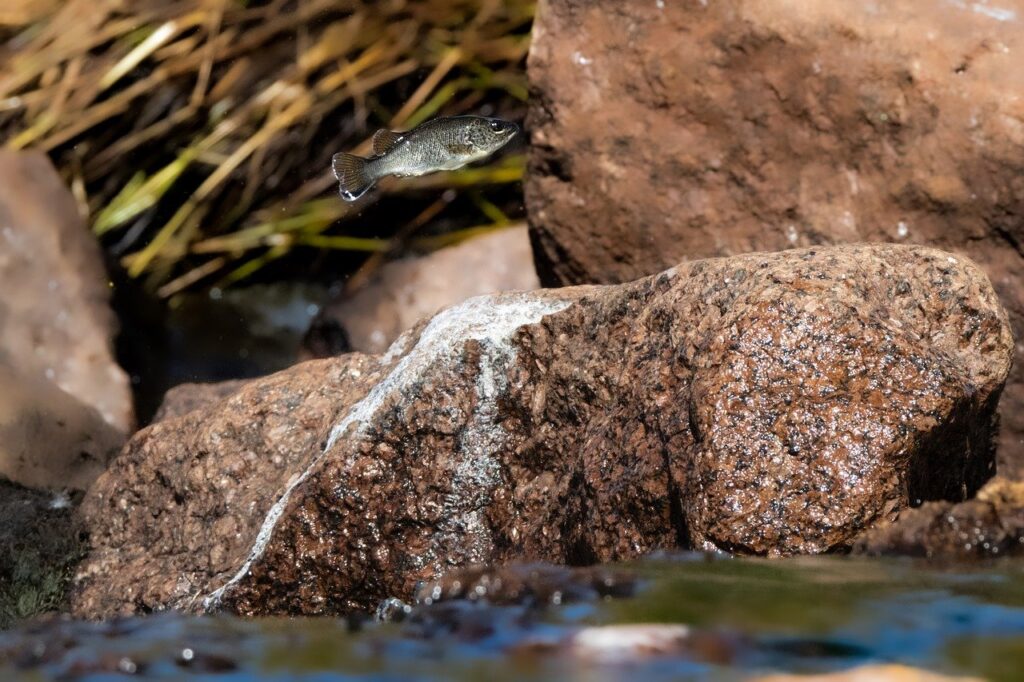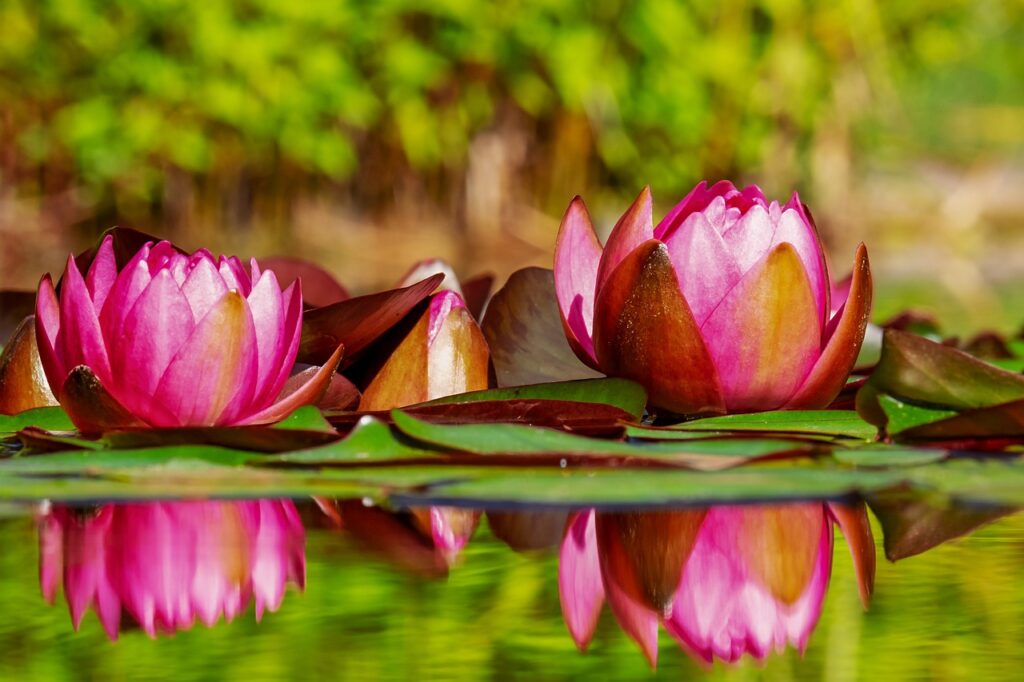Maintaining crystal-clear water in your fish pond is not only aesthetically pleasing but also essential for the health and well-being of your fish. How to keep fish pond water crystal clear is a question asked regularly, in particular during the hotter weather periods.
There are various measures you can take to ensure the water in your fish pond remains pristine, from effective filtration systems to regular cleaning and careful monitoring of water quality. Today we will explore some tried and tested methods to help you achieve and sustain crystal-clear water in your fish pond, allowing you to create a tranquil and captivating aquatic environment for your beloved fish.

Regular Water Testing
To ensure the health and clarity of your fish pond water, regular water testing is essential. By monitoring the key parameters of your pond water, you can detect any imbalances or issues early on and take appropriate measures to correct them. Here are the main tests you should perform:
Test the water for pH levels
Maintaining proper pH levels is crucial for the overall well-being of your fish and the overall health of your pond ecosystem. Most pond fish prefer a slightly alkaline pH range, usually between 7.0 and 8.5. Testing your pond water’s pH regularly will allow you to make any necessary adjustments using pH regulators or buffers to keep the levels within the optimal range.
Test for ammonia levels
Ammonia is excreted by fish and can accumulate in the water, leading to toxicity and potential harm to the fish. Testing for ammonia levels is vital to ensure a healthy aquatic environment. Ideally, ammonia levels should be kept at zero or at very low levels. If elevated ammonia levels are detected, you should consider increasing oxygenation, reducing fish population, or implementing biological filtration systems to eliminate or dilute the ammonia.
Test for nitrite levels
Nitrite is a byproduct of the breakdown of ammonia in your pond. While less toxic than ammonia, high nitrite levels can still be harmful to your fish. Regularly testing for nitrite will allow you to detect any imbalances and take appropriate actions. Nitrite levels should be maintained at or close to zero. Treatment options include increasing filtration capacity, minimizing fish waste, and conducting frequent partial water changes.
Test for nitrate levels
Nitrate is the end product of the nitrogen cycle in your pond water. While it is less toxic than ammonia and nitrite, high nitrate levels can still negatively impact the health and clarity of your pond. Testing for nitrate levels provides valuable information about the efficiency of your biological filtration and nutrient management. Nitrate levels should be kept below 40 mg/L or according to the specific requirements of your fish and plants. Regular water changes, planting aquatic plants, and using nitrate removers can help control nitrate levels.
Maintaining Proper Filtration
Having a good quality filtration system is vital for keeping your fish pond water crystal clear. A reliable filtration system helps remove debris, organic matter, and excess nutrients from the water, promoting a healthy and balanced aquatic environment. Here are some key aspects to consider when it comes to maintaining proper filtration:
Install a good quality filtration system
Investing in a high-quality filtration system is crucial for effective water filtration. The chosen system should be suitable for the size and specific needs of your pond. A combination of mechanical, biological, and chemical filtration should be considered for optimal results. Ensure the filtration system is properly sized and meets the recommended flow rate to adequately filter the volume of water in your pond.
Clean or replace filter media regularly
The filter media in your filtration system plays a significant role in removing impurities from the water. Over time, these media can become clogged with debris and organic matter, reducing their efficiency. It is important to clean or replace the filter media periodically to maintain optimal water filtration. Follow the manufacturer’s instructions for proper cleaning and replacement procedures.
Ensure proper water flow through the filter
Proper water flow through the filtration system is crucial for effective filtration. Insufficient water flow can lead to poor filtration and stagnant water, while excessive flow can disturb the ecosystem balance. Regularly check the water flow rate and adjust as needed to ensure a balanced and efficient filtration process.
Consider adding a UV sterilizer
A UV sterilizer can be a beneficial addition to your filtration system, particularly if you are experiencing persistent algae or bacterial problems. UV sterilizers use ultraviolet light to kill or control harmful microorganisms, helping to maintain water clarity and prevent disease outbreaks. Consult with a professional or do thorough research to determine if a UV sterilizer is suitable for your specific pond requirements.
Optimizing Biological Balance
Achieving and maintaining a healthy biological balance is essential for the overall well-being and clarity of your pond water. A balanced pond ecosystem promotes the breakdown of organic matter, controls nutrient levels, and reduces the risk of algae blooms and water imbalances. Here are key strategies to optimize the biological balance in your fish pond:
Maintain a balanced fish population
Overstocking your pond with fish can lead to excessive waste production and elevated nutrient levels, which can ultimately impact water quality. It is important to maintain a balanced fish population based on the size and capacity of your pond. Consult with a professional or research the recommended stocking densities for your specific fish species to ensure a healthy and sustainable environment for your fish.
Avoid overfeeding the fish
Overfeeding your fish can result in excessive nutrient buildup and waste production. This can lead to poor water quality and the growth of harmful bacteria and algae. Feed your fish in appropriate quantities and only what they can consume within a few minutes. Monitor their feeding behavior and adjust the amount accordingly. Additionally, consider using high-quality fish food that is specifically formulated for your fish species to minimize nutrient waste.
Add beneficial bacteria to the pond
Beneficial bacteria play a crucial role in maintaining a healthy pond ecosystem. These bacteria help break down organic waste and convert harmful substances like ammonia and nitrite into less toxic forms. Adding beneficial bacteria products to your pond regularly can enhance the biological filtration capacity and promote a clearer and healthier aquatic environment. Follow the manufacturer’s instructions and dosage recommendations when introducing beneficial bacteria.
Provide sufficient oxygen in the water
Adequate oxygen levels are essential for the well-being of your fish and other pond organisms. Insufficient oxygen can lead to stress, reduced immune function, and poor overall health. Ensure proper aeration and water movement in your pond to promote oxygen exchange.
This can be achieved through the use of pond pumps, air stones, waterfalls, or fountains. Regularly monitor oxygen levels and adjust aeration as needed to maintain optimal conditions for your fish and pond ecosystem.
Controlling Algae Growth
Algae growth is one of the most common challenges pond owners face when aiming to keep their pond water crystal clear. While some amount of algae is natural and even beneficial for the ecosystem, excessive algae growth can lead to unsightly water conditions and disrupt the balance of your pond. Here are some strategies to help you control algae growth effectively:
Keep the pond shaded
Excessive sunlight exposure can fuel algae growth. Providing shade to your pond, especially during the peak hours of sunlight, can help reduce the intensity of algae growth. This can be achieved by planting trees, installing shade sails, or utilizing floating plants that provide canopy coverage.
Add aquatic plants for natural filtration
Aquatic plants not only enhance the aesthetic appeal of your pond but also play a crucial role in naturally filtering the water. These plants help absorb excess nutrients, compete with algae for resources, and provide oxygenation. Consider adding a variety of submerged, floating, and marginal plants to your pond to optimize natural filtration and discourage algae growth. Research the specific plant requirements and choose suitable species for your pond’s conditions.
Use algae control products if necessary
In cases where algae growth becomes excessive or starts to negatively impact the water quality, the use of algae control products can be considered. Algaecides or other algae control treatments can help combat existing algae blooms and prevent further growth.
However, it is vital to follow the instructions and dosage recommendations carefully, as some products can have adverse effects on fish, plants, or other pond organisms. Seek professional advice or consult with a knowledgeable supplier for guidance on choosing and using algae control products.
Regularly remove excess debris or organic material
Leaves, twigs, and other organic debris that accumulate in your pond provide nutrients for algae growth. Regularly remove any excess debris from the surface and bottom of the pond to prevent the buildup of organic matter. This can be done using nets, pond skimmers, or manual cleaning.
By minimizing the nutrient inputs, you can discourage excessive algae growth and maintain clearer water conditions.

Minimizing Fish Waste
Fish waste is one of the primary contributors to nutrient buildup and water quality issues in a fish pond. Proper management of fish waste is crucial to ensure a healthy and pristine aquatic environment for your fish. Here are some strategies to minimize fish waste effectively:
Install a dedicated fish waste removal system
Installing a dedicated fish waste removal system can help efficiently remove solid waste from your pond. These systems typically include bottom drains connected to a mechanical filter that catches and traps fish waste particles, preventing them from decomposing and affecting water quality. Consult with a pond professional or reputable supplier to determine the appropriate fish waste removal system for your specific pond setup.
Use bottom drains for efficient waste removal
Bottom drains are designed to draw water from the bottom of the pond, carrying along any settled debris or fish waste. Incorporating bottom drains into your pond design or retrofitting them into an existing pond can significantly aid in waste removal. The waste can then be directed to a mechanical filter or a dedicated waste removal system for proper disposal.
Perform regular partial water changes
Regular partial water changes are an effective way to dilute nutrient concentrations and remove excess fish waste. By replacing a portion of the water with fresh, dechlorinated water, you can help maintain better water quality and reduce the risk of nutrient imbalances. Aim to perform partial water changes at least once every few weeks or as needed, depending on the size of your pond, fish stocking density, and water quality parameters.
Clean the pond bottom regularly
The accumulation of fish waste and debris on the pond bottom can lead to adverse water conditions and algae growth. Cleaning the pond bottom periodically, especially in areas where waste tends to accumulate, can help prevent nutrient buildup and promote clearer water. Use a pond vacuum or similar equipment to remove the waste without disrupting the overall balance of the pond.
Preventing Excessive Nutrient Levels
Excessive nutrient levels are a major contributor to poor water quality and the proliferation of algae in fish ponds. Proper nutrient management is therefore critical to keep your pond water crystal clear. Here are some measures you can take to prevent and control excessive nutrient levels:
Avoid overfeeding the fish
As mentioned earlier, overfeeding fish can result in excess nutrient input, leading to poor water quality and algae growth. Feeding your fish in appropriate amounts and adjusting the feeding frequency based on their needs will help minimize nutrient excesses. Monitor their feeding behavior and adjust accordingly to ensure they consume their food without leaving leftovers that contribute to nutrient buildup.
Limit or remove excess fish food
When fish food is not consumed and remains uneaten, it becomes a source of excess nutrients in the pond. Limiting the amount of food you provide and monitoring the fish’s behavior during feeding can help prevent excess food from accumulating in the water. If you notice any leftover food after feeding, remove it promptly to reduce nutrient inputs.
Monitor and control nutrient inputs
Apart from fish waste and excess food, other factors may contribute to nutrient imbalances in your pond. Chemical fertilizers, runoff from adjacent areas, and decaying organic matter can introduce excessive nutrients into your pond. Regularly inspect and control these nutrient inputs by avoiding the use of fertilizers near the pond, redirecting runoff away from the pond, and removing decaying organic matter from the water.
Use phosphate binders if necessary
Phosphates are a type of nutrient that can fuel algae growth in your pond. If your water tests consistently indicate high phosphate levels, consider using phosphate binders. These products help reduce phosphate concentrations in the water by effectively binding and removing them. Research and choose an appropriate phosphate binder product that is safe for your fish and plants, and follow the dosage instructions carefully.

Maintaining a Healthy Plant Balance
Aquatic plants bring beauty, balance, and valuable biological functions to your fish pond. Properly maintaining a healthy plant balance is crucial for the overall water clarity and ecological stability of your pond ecosystem. Here are some guidelines to help you achieve and maintain a thriving plant environment:
Regularly prune and remove decaying plant matter
As plants grow, they may develop dead or decaying parts that can compromise water quality if left unattended. Regularly prune and remove any dead or decaying plant matter from your pond to prevent nutrient release and deterioration of the water. This will help maintain a healthier plant balance and reduce the risk of algae growth.
Avoid overstocking plants
While aquatic plants play a vital role in maintaining water quality, overcrowding your pond with too many plants can lead to excessive nutrient competition and imbalances. Carefully plan and select the appropriate number and types of plants based on the size and capacity of your pond. Consider the specific requirements and growth habits of the plants to ensure they can thrive and contribute to a healthy pond environment.
Control invasive plants
Some aquatic plants have the potential to become invasive and cause harm to the natural balance of your pond ecosystem. Monitor your pond regularly for any signs of invasive plant growth, such as rapid spreading or choking of other plants. If invasive species are detected, take prompt action to remove and control their growth to prevent negative impacts on water quality and the overall pond habitat.
Fertilize plants appropriately
To promote optimal plant growth and vitality, fertilization may be necessary. However, it is important to fertilize your aquatic plants with caution and in moderation. Applying excessive fertilizers can lead to nutrient imbalances and algae growth. Research the specific fertilizer requirements of your plants and use slow-release or organic fertilizers to minimize the risk of nutrient overload.
Managing Water Temperature
Water temperature plays a significant role in the overall health and well-being of your fish and pond ecosystem. Extreme temperature fluctuations can stress fish and affect the efficiency of your pond’s biological processes. Here are some tips for managing water temperature in your fish pond:
Provide shade to prevent excessive temperature fluctuations
Direct sunlight can cause rapid temperature fluctuations in your pond, especially during hot summer days. Providing shade to your pond can help reduce temperature fluctuations and minimize stress on your fish. This can be achieved by planting trees or installing shade sails or other shade-providing structures.
Use water heaters or coolers if needed
In regions with extreme temperature conditions, it may be necessary to use water heaters or coolers to maintain a stable water temperature in your pond. Water heaters can help prevent freezing of the pond during cold winter months, while coolers can be used to lower the water temperature during hot summer periods. Consult with a professional or reputable supplier to determine the appropriate devices and settings for your specific pond requirements.
Avoid extreme temperature changes
Sudden or drastic temperature changes in your pond water can negatively impact the health of your fish and disrupt the balance of your pond ecosystem. Take precautions to avoid extreme temperature fluctuations, such as providing gradual changes in water temperature during water additions or performing partial water changes with water of similar temperature. Avoid introducing water that is too hot or too cold, as this can shock the fish and disturb the entire ecosystem.
Monitor and control sunlight exposure
Sunlight exposure directly affects the temperature of your pond water. Excessive sunlight can raise the water temperature, while limited sunlight can lead to cooler conditions. Monitor the sunlight exposure in your pond and consider adjusting the shade coverage or adding shading structures to regulate the temperature. Observe the behavior and health of your fish, plants, and other pond organisms to ensure they are not being negatively affected by temperature extremes.

Ensuring Good Water Circulation
Proper water circulation is essential for maintaining a healthy and vibrant fish pond. Adequate water movement helps distribute oxygen, nutrients, and heat evenly throughout the pond, promoting a balanced ecosystem and crystal clear water. Here are some strategies to ensure good water circulation in your fish pond:
Install a pond pump for proper water circulation
A reliable pond pump is essential for creating water movement and circulation in your pond. The pump should be sized appropriately based on the volume of water in your pond and the desired flow rate. Place the pump in a strategic location to maximize water circulation, ensuring that all areas of the pond benefit from the flow.
Use aeration devices to increase oxygen levels
Adequate oxygenation is critical for the health and well-being of your fish and other pond organisms. Aeration devices, such as air stones or diffusers, can help increase oxygen levels in the water. These devices release small bubbles that actively mix the water and facilitate gas exchange. Install the aeration devices in locations that provide optimal coverage of the pond volume.
Avoid stagnant areas in the pond
Stagnant areas in your pond can become breeding grounds for bacteria and algae, leading to poor water quality and reduced clarity. Design and construct your pond with attention to eliminating stagnant areas. Ensure that water flows evenly throughout the pond, reaching all corners and incorporating the tips of plant foliage. Regularly inspect your pond for any areas where water movement may be restricted, and take corrective measures if needed.
Consider adding waterfalls or fountains
Waterfalls and fountains are not only visually appealing but also contribute to effective water circulation. These structures create movement and aeration in the water, helping maintain oxygen levels and preventing stagnation. Additionally, the sound of flowing water adds a soothing element to your pond environment. Research and choose suitable waterfall or fountain designs that integrate well with your pond layout and enjoy the aesthetic and functional benefits they provide.

Regular Maintenance and Cleaning
To keep your fish pond water crystal clear, regular maintenance and cleaning are essential. By staying on top of the necessary tasks, you can prevent issues from escalating and maintain a healthy and attractive pond environment. Here are some important maintenance and cleaning practices to keep in mind:
Remove debris and fallen leaves from the pond
Debris and fallen leaves can accumulate on the surface of your pond, leading to nutrient buildup and poor water quality. Regularly skim and remove any debris from the surface using a pond net or skimmer. Pay extra attention during the fall season when leaves tend to drop more frequently. By promptly removing debris, you can minimize the negative impact on water clarity and prevent excessive organic matter decomposition.
Check and clean pond equipment regularly
Regularly inspect and clean your pond equipment to ensure proper functionality. This includes pumps, filters, UV sterilizers, and aeration devices. Follow the manufacturer’s instructions for maintenance and cleaning procedures. Pay attention to any signs of wear or damage and take appropriate action to repair or replace faulty equipment. Well-maintained equipment ensures efficient filtration, water circulation, and oxygenation.
Trim and maintain surrounding vegetation
The vegetation surrounding your pond can have a significant impact on water quality and clarity. Overgrown plants or trees can shed leaves and debris directly into the pond, leading to increased nutrient loads and poor water conditions. Regularly trim and maintain the vegetation around your pond, keeping it clear from overhanging branches and excessive growth. This will help reduce the amount of organic matter that enters your pond and minimize the risk of nutrient imbalances.
Inspect and repair any leaks or damages
Regularly inspect your pond for any signs of leaks, damages, or structural issues. These issues can compromise water quality, cause water loss, and disrupt the integrity of your pond system. Ensure that the liner, edges, and base of your pond are intact and well-maintained. If any leaks or damages are detected, take immediate action to repair and reinforce the affected areas, preventing any further problems from arising.
How To Keep Fish Pond Water Crystal Clear
By following these guidelines and implementing proper care and maintenance practices, you can ensure that your fish pond water remains crystal clear. Regular water testing, proper filtration, biological balance, algae control, waste management, nutrient control, plant care, temperature management, water circulation, and routine maintenance will all contribute to a vibrant and thriving pond environment. Enjoy the beauty and serenity of your fish pond as you provide the ideal conditions for your fish and plants to flourish.
Other ways to learn about keeping your fish pond pristine, is by reading up on information about your hobby, such as ‘How To Know When A Pond Is Ready For Fish‘, as you can never know enough without taking the time to learn about it.
